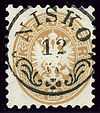Nisko
| Nisko | |||
|---|---|---|---|
 | |||
| |||
 Nisko | |||
| Coordinates: 50°32′N 22°8′E / 50.533°N 22.133°E | |||
| Country |
| ||
| Voivodeship |
| ||
| County | Nisko County | ||
| Gmina | Gmina Nisko | ||
| Government | |||
| • Mayor | Julian Ozimek | ||
| Area | |||
| • Total | 61.02 km2 (23.56 sq mi) | ||
| Population (2006) | |||
| • Total | 15,637 | ||
| • Density | 260/km2 (660/sq mi) | ||
| Time zone | CET (UTC+1) | ||
| • Summer (DST) | CEST (UTC+2) | ||
| Postal code | 37-400 | ||
| Car plates | RNI | ||
| Website | http://www.nisko.pl | ||
Nisko [ˈɲiskɔ] is a town in Nisko County, Subcarpathian Voivodeship, Poland on the San River, with a population of 15,534 inhabitants as of 2 June 2009.[1] Together with neighbouring city of Stalowa Wola, Nisko creates a small agglomeration.
History
Nisko formerly belonged to that part of the kingdom of Poland which was attributed to the Habsburg monarchy at the second partition of Poland in 1785.[citation needed] In 1867 Count Eugene Kinsky bought the estate to give to his daughter Countess Marie Kinsky of Wchinitz and Tettau as a wedding present, which took place in Vienna on 21 September 1868. From 1868 to 1912 under Count Oliver Rességuier de Miremont and his family, the village grew to become one of the largest estates in then Austrian Galicia. A railroad station, a hospital, a church (three in present-day Nisko), schools, factories, Austrian Army Base (currently Polish Army Base) and a palace (now used as a hospital building) were built. Most of these buildings are still in use. The village was also the capital of administration unit, Nisko County.
In 1914, when World War I began, many buildings in Nisko were destroyed by the Russian Army, which attacked Austria-Hungary. In 1918, local Poles gained control over the government in Nisko and the village became part of the new-formed Second Polish Republic. After the war, Nisko began developing very quickly but did not become a town until 1933. In 1938, the Polish government made Nisko part of the Central Industrial Area. It was a milestone in history of the town, because several projects were started in the area, such as a foundry and a power-plant in the forests on the western boundary of Nisko. The programme of industrialization was stopped with the invasion of Poland by Nazi Germany and Soviet Union in 1939.[citation needed]
When Poland was occupied by German forces during World War II, Nisko became part of the Nazi government's plan to annihilate the Jews. Beginning in 1939, many Jews were shipped to a reservation at Nisko, where they were left to fend for themselves. At this point in Nazi Germany, the policy of mass Jewish killings had not yet taken shape and Germany's plan still seemed to be the indirect death of European Jews through exile and deportation to inhabitable locations without sufficient supplies, rather than outright murder in extermination camps. This was known as the "Nisko Plan".[citation needed]
While many Jews were shipped to Nisko and left to die without sufficient food or shelter, the plan of creating a reservation was abandoned. The relocation of Jews to Nisko is sometimes viewed as a stepping-stone in German policy towards the widespread placement of Jews in ghettos throughout Europe, which the German government began to do shortly after the invasion of Poland in 1939 and, finally, the mass deaths of Jews at the hands of the Nazi government in extermination camps.[2]
Since 1999, Nisko has been situated in the Subcarpathian Voivodship.
Education
- Wyższa Szkoła Informatyki i Zarządzania in Rzeszów, branch in Nisko
Sports
- Sokol Nisko - a football team, playing in local division
Twin towns — Sister cities
Nisko is twinned with:
|
|
References

- ↑ "Population. Size and structure by territorial division". Warsaw: Central Statistical Office. 2 June 2009. Retrieved 22 June 2009.
- ↑ http://www1.yadvashem.org/odot_pdf/microsoft%20word%20-%205965.pdf
Sources
- "Central Statistical Office (GUS)". TERYT (National Register of Territorial Land Apportionment Journal) (in Polish). 01.09.2008. Retrieved 23 October 2008.
- "Nisko Official Website". UGiM Nisko. 1999–2008. Retrieved 23 October 2008.
| Wikimedia Commons has media related to Nisko. |
| ||||||||||||||
| ||||||||||

